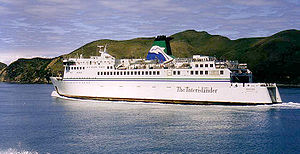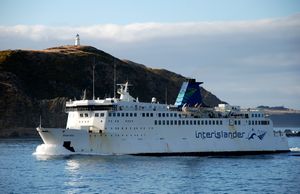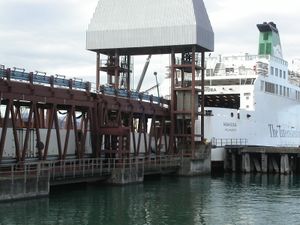Arahura (ferry)
 DEV Ahahura in "Pelorus Jack" livery in the Marlborough Sounds | |
| Career | |
|---|---|
| Name: | Arahura |
| Owner: | New Zealand Government |
| Operator: | Interislander |
| Port of registry: | Wellington, 22x20px New Zealand |
| Route: | Wellington to Picton |
| Builder: | Aalborg Vaerft A/S shipyard, Denmark. |
| Launched: | 1981 |
| Christened: | 1982 |
| Completed: | 1982 |
| Maiden voyage: | 1982 |
| In service: | 1983 |
| Status: | In service |
| General characteristics | |
| Tonnage: | 13621 tonnes |
| Length: | 148 metres (486 ft) |
| Beam: | 20.5 metres (67 ft) |
| Decks: | 9 |
| Installed power: | Four Wartsila 12V32 diesel engines, each producing 3800 kW at 750 rpm |
| Propulsion: | Two KaMeWa Controllable pitch propellers, each four blades inward turning and 4.6 m (15 ft) in diameter. |
| Speed: | 20 knots (37 km/h) |
| Capacity: |
550 passengers 142 cars 60 rail vehicles |
| Crew: | 65 |
The DEV Arahura is a roll-on roll-off diesel-electric rail ferry in service for Interislander in New Zealand. The ferry was built for the New Zealand Railways Corporation in 1982 to replace the aging MV Aramoana and MV Aranui for the Cook Strait route between Wellington and Picton. The name Arahura means "Pathway to Dawn" in the Māori language. She is the only vessel in the fleet owned by KiwiRail (Aratere and Kaitaki are leased) and is expected to remain in service until 2016 [1].
History
Arahura is the second inter-island ferry to bear the name. The original Arahura was a twin screw steam ship built for the Union Steamship Company in 1905. This ship served until the early 1950s and was sunk by the RNZAF as target practice. The current Arahura was delivered in 1983. She was designed to operate at a higher service speed than the existing ferries on the route, while reducing waves that would affect nearby beaches. This decreased Cook Strait crossing times by 20 minutes. [2]
In 1986, Arahura helped rescue passengers from the Mikhail Lermontov. She was invaluable providing lifeboats and extra assistance to the sinking Russian cruise liner.
On September 30, 1987, Arahura snapped her moorings and floats free, straddling Kings and Glasgow Wharves in Wellington.
On April 11, 1989, Arahura listed 40 degrees during a routine sailing from Picton to Wellington.
In 2008, Arahura underwent a $NZ 9m refit to better accommodate larger trucks and campervans. This included reducing some of the upper decks and a new cinema and cafeteria. [3]. [4]
Livery
Arahura has changed liveries twice in her lifetime. Originally, she had a green hull and yellow, red, and black on the funnel [5][6]. In 1989, the inter-island service was re-branded as a "ferry cruise", and the livery of all the ferries was replaced with a white hull with blue and green stripes. The funnels now carried a stylized 'Pelorus Jack', a dolphin famous for assisting vessels navigating across the Cook Strait. The liveries were changed again in 2004. Pelorus Jack was relocated to the hull and the funnels were now blue with a fern replacing Pelorus Jack.
Propulsion
Arahura is a diesel electric vessel and has a fuel capacity of 450,000 litres and was built with the capability to provide power ashore for civil defence or similar emergencies providing 14 MW power - enough power to light all the houses in Wellington. During her lifetime so far, Arahura has made over 24000 return crossings across Cook Strait.
Deck Layout
Rail and road vehicles are loaded and unloaded through the stern of the ship via a double linkspan. Passengers without vehicles board through a walkway on the starboard side.
- Decks 1 and 2 are below the waterline and contain the ship's engines, fuel tanks etc
- Deck 3 is the rail deck, which can also hold motor vehicles.
- Deck 5 is the dedicated vehicle deck
- Deck 7 contains passenger accommodations, including a play area, video arcade, food court, cinema, and store.
- Deck 8 contains the passenger observation decks and the Queen Charlotte Cafe and Bar
- Deck 9 houses the bridge and officers' quarters. She carries approximately 70 crew, half of whom live on-board on a 7 days on, 7 days off roster cycle.
References
- ↑ "Strait ferries weigh on government books". Television New Zealand. http://tvnz.co.nz/content/2479724?cfb3=3. Retrieved 2009-10-04.
- ↑ "Arahura - New Zealand Maritime Record". New Zealand Maritime Record. http://www.nzmaritime.co.nz/arahura.htm. Retrieved 2009-10-04.
- ↑ "Arahura 2008". New Zealand Ship and Marine Society. http://www.nzshipmarine.com/history/photo.aspx?id=879. Retrieved 2009-01-02.
- ↑ "Interislander ferry Arahura to get $9m refit". The New Zealand Herald. http://www.nzherald.co.nz/nz/news/article.cfm?c_id=1&objectid=10505832. Retrieved 2009-01-02.
- ↑ "Arahura 1987". New Zealand Ship and Marine Society. http://www.nzshipmarine.com/history/photo.aspx?id=554. Retrieved 2009-01-02.
- ↑ "Simplon Postcards - Arahura". Simplon Postcards. http://www.simplonpc.co.uk/Interislander.html#anchor91185. Retrieved 2009-10-04.


